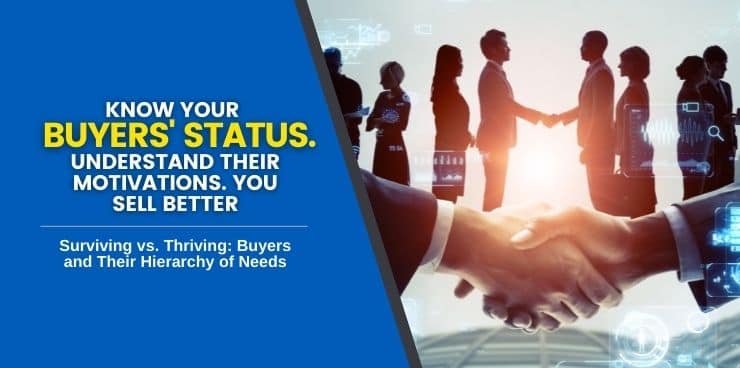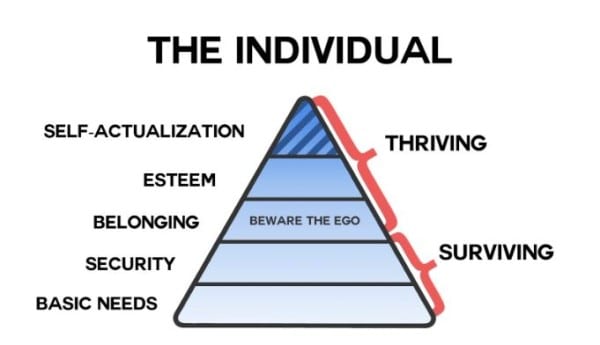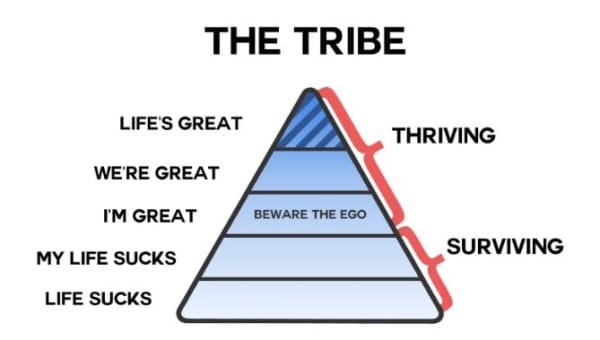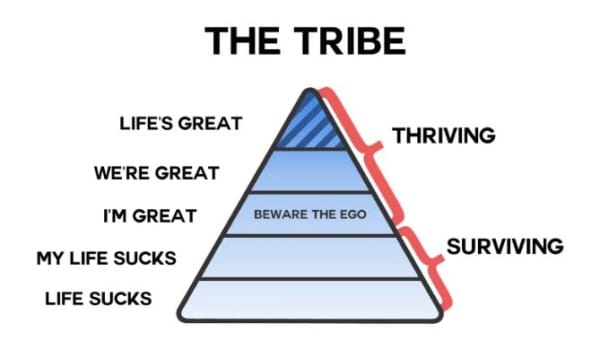
Yeah but… MY customers are different. This is the most common phrase in a business owners toolbox when looking to explain why the sale wasn’t made. Having had the opportunity to sell across the world, I can say definitively that while cultures and economies differ, human psychology does not. When we take a closer look at the Americans, you’ll find that every market follows a bell curve from surviving to thriving shoppers.
What does this mean?
In general, there are only two types of buyers: those who are merely surviving and those who are thriving. Within each group is an existing hierarchy of needs that ultimately form their emotional motives and in turn, buying motives.
How does this work for your business?
Simple.
In your line of work, you’ll encounter buyers from all walks of life. They may have varying vocations and come from different cultures, but they’ll always fall somewhere from surviving to thriving. They are people who have defined types of motives in which their buying behaviors are anchored. Let me put it this way, knowing what psychological triggers to tug means having better odds of securing the sale.
Simple human motives drive every consumer’s buying behavior: from engagement to transacting, down to the sale itself. If you want to learn your buyers’ motivation, keep on reading.
Maslow’s Hierarchy of Needs
You’ve probably heard of Maslow’s Hierarchy of Needs. It is one of the most widely accepted and popular theories that explain human motivation. The Hierarchy of Needs is a model that illustrates the different types of motives that drive human behavior. In the context of business, you can use the hierarchy of needs to uncover a customer’s buying behavior. According to Maslow, certain psychological and physiological needs are the impulses behind our every action.
What made Maslow’s theory one of a kind is its originality. During the time when psychoanalysis and behavioral theories plagued the psychological scene, most psychologists focused on problematic behavior. Meanwhile, Maslow was more interested in what made people happy. He made it his purpose to uncover people’s source of positive resonance or “what makes them feel right.” Maslow also tried to uncover what people do to achieve that state.
Enter, Maslow’s Hierarchy of Needs.
The Individual

Drawing references from Maslow’s Hierarchy of Needs can help us understand the different types of motives that influence human behavior. Maslow said an individual goes through 5 fundamental stages. People ascend through each as they achieve the rudimentary needs within each phase. The stages are as follows and in order:
- Basic or physiological needs
- Security or safety needs
- Belonging needs
- Esteem needs
- Self-actualization needs
At the most basic level, we have Survival Needs (Levels 1 and 2). These are the physiological needs that are required for us to stay alive. This includes elements like air, water, food, and shelter. Once these needs are met, we move on to our Thriving Needs (Levels 3 to 5). Thriving Needs are what give our lives purpose and meaning. They include things like love, belonging, pursuing a greater cause, being a part of something bigger than ourselves, and self-actualization, the complete and utter abandonment of the Ego.
When it comes to most shoppers in G1 Countries, we can think of them hovering between Level 2 and 3 of surviving vs. thriving. Surviving buyers are those who are motivated by their Surviving Needs. This may mean they’re focused on getting the best deal possible and doing whatever it takes to save money. On the other hand, thriving buyers are motivated by their Thriving Needs. They’re much more capable of paying a reasonable premium in exchange for competent convenience.
It’s important to understand where your buyers fall on this spectrum. This will help shape what kind of messaging and approach you should take.

Surviving vs. Thriving
We all know that making a sale is all about aligning with your buyer’s beliefs. The psychological tug-of-war concealed in the guise of a transaction is what makes or breaks the sale. Since all buyers are either surviving or thriving, their psyche operates on the category they belong to. If you want to be more persuasive, you need to phrase your communication from their frame of thought.
In other words, speak to the dog in the language of the dog about what the dog cares about.
A buyer who is living in survival mode is motivated by different things than those in the thriving mode. You have to know what makes them stop what their are fussing about and pay attention to you.
The Tribe

Now that we’ve looked into the category that each individual belongs to, let’s now see them clustered into groups via tribes. In the U.S. most people either belong to Level 2-Survival Mode or Level 3-Thriving Mode. I’ll explain why below.
Level 1-Survival Mode is the realm of anarchy. A living condition wherein hoarding resources, looting, pillaging, murder, and theft pervade in an attempt to survive. Needless to say, life sucks (in general). Naturally, people within this tribe don’t see the need and don’t have the means to afford basic services.
Level 2-Survival Mode is a bit different. This occurs when economics favor the Level 1 tribe and they manage to attain their basic needs. This includes needs like food, water, shelter, and even humble work. People at this level still get a few bucks to make ends meet. Nevertheless, they’re doing better to afford some basic conveniences like, for example, residential home services. However, they’re not doing well enough compared to their neighbors in Level 3-Thriving Mode. For this reason, they often think to themselves “my life sucks.”
Level 3-Thriving Mode is the plane where life affords them some discretionary comforts, access to non-essentials, and services. People within this level are doing decent enough at work and are paid a good amount to say “I’m great.” The problem is that this is also where most believe their naughty Ego. This forces people to overextend their budget in an attempt to keep up with the Joneses. That said, most people in the Level 3-Thriving Mode tread a thin line. One wrong step can bring them back gasping into survival mode.
Those who break through to Level 4 and Level 5-Thriving Mode are the ones who stuck through discipline. They are individuals who made the active choice to abandon vanity, and the Ego behind. They represent a small, often negligible, percentage of your entire market. If you get clients from these levels, they normally share the love for competent convenience as those in Level 3.
How then do you sell your products or services to people belonging to the Surviving vs. Thriving mode? Let’s check out below!
 Survival Mode
Survival Mode
Surviving (vs. Thriving) buyers are naturally more “transactional.” This means they are likely to deploy logic, use metrics like ROI, and jump from shop to shop to protect their most rudimentary resource — money. Their goal is to find the lowest price overall, which is the deciding factor in their overall buying behavior.
The thing is, being in survival mode is not a measure of wealth and net worth. Survival mode is a mindset. Wealthy misers who irrationally value their money more than their time also belong in this category.
Since survival mode buyers are trying to protect their money the most, they are naturally going to be more price sensitive. They’ll typically lean on cognitive biases in lieu of common sense. Show them how your products can soothe their pain points (fear, shame, and guilt) or caress their pleasure points (identity, purpose, and adventure). Indulge their extreme inclination to their underlying felt needs (money, energy, and time). The success of your sale relies on how desirable your value proposition is despite reasonable pricing. In short, stack that value and be ready to eliminate value for the cheapest price.
Note: Transactions with survival mode buyers don’t always work especially when your price is more than what they’re willing to pay. The reason? The more invested survival mode buyers are in their survival instincts, the less they’ll care about your value proposition. As a result, survival mode buyers who are further down the hierarchy will always gravitate to the cheapest price. They’ll choose the cheapest upfront price, not the best solution. Be willing to abandon these people or have a solution that will accommodate their limiting beliefs.
Thriving Mode
Thriving mode buyers, on the other hand, are still concerned with price, but factor their time and stress into the equation. That’s why they are more “relational” in nature. They are willing to invest in your team and your company in exchange for empathy and competency. They’re not so much included to have a relationship with your brand, but they are looking for a more human connection to ensure they get a the right solution the first time. This includes the upfront investment, but also the longterm connection to minimize future risk and stress.
Set it and forget it. One and done. Make it go away. Handle the ongoing maintenance for me. Protect me from unexpected failure. These are the sentiments of a relational buyer and a relational buyer has a thriving mindset.
Time and money spend on externally triggered grudge purchases cause negative energy (stress, anxiety, frustration). Therefore, both your surviving and thriving customers are looking to eliminate what stresses them out and get back to a baseline of happy, or better!
Everything is a pursuit of (positive) energy. Said differently, everyone is on an endless pursuit of happiness. This include ridding themselves of stressors and surrounding themselves with rewards.
Instead of spending valuable time finding the cheapest seller, thriving mode buyers are willing to pay a reasonable premium for competent convenience. Provided, of course, you offer a desirable value proposition and display the right selling signals. When you exhibit characteristics like empathy, competence, great work ethics, and outstanding customer service, it’s your sale to close.
Relational buyers in thriving mode fear making the wrong choice with the products and the provider they choose. For this reason, they’ll buy into your offer quicker when you fulfill their underlying felt needs by satisfying their pain and pleasure points.
 The 3 CORE Pleasure Points
The 3 CORE Pleasure Points
When finding service providers, surviving vs. thriving buyers starting from a place of negative resonance. Something is either doing something it shouldn’t or it is not doing something it should. They don’t want your services, they are forced to get it against their will. If there is no discernible difference between you and your competitor, the first measuring stick will always be price. The more urgent the matter, the more time factors into the equation.
“All things being equal, people want to buy from their friend. All things not being so equal, people want to buy from their friends.” – Jeffrey Gitomer
Thriving mode buyers have more money to spend on competent, convenient service. They are judging you on selling signals that confirm that you are like them.
65% of people are driven by the desire to belong or keep up with the Joneses. Whether they are surviving or thriving, they aspire to be accepted and belong. This predisposes people to find a way to get the best solution based on their current mindset – surviving vs. thriving.
For those relational buyer who have a thriving mindset, you are going to be able to appeal to their 3 strongest internal motivations. Below are their 3 CORE pleasure points:
Identity
Who are my people? Who would I be proud to associate my good name with? Who believes what I believe when it comes to my family’s comfort, safety, and savings? Who will alleviate my stress while buying, but also during the installation process and the long term after care? Who will be there to help me quickly and effortlessly if something unexpected arises?
When your buyer is proud to associate their brand with your brand, you are doing it right. Expect to close them on the first sit at a higher average sale and profit. Expect them to refer their loved ones unsolicited and give you a hearty 5-star review. Just be careful not to break their trust.
Identity is also an expression of their style and competence. When you install a fancy metal roof, or a G4 Toto toilet, you are helping your buyer show the world what kind of person they are. Whether it is in an effort to attract (or keep) a desirable mate, or to reinforce their self-worth, identity is the single most powerful internal motivator.
Purpose
Thriving buyers buy things that help them achieve their purpose in life. When they value their time more than money, they are chasing their purpose. In services, when you can provide them with comfort, safety, and savings in a timely manner with little disruption in their lives, you are helping them realize their dreams — their purpose.
For those that don’t relate with a driving purpose, they are often focused on reinforcing their identity as their primary purpose.
Adventure
Adventure is in many ways the pursuit of happiness. While some buyers enjoy the buying process, others detest it. Some see this purchase as a challenge, while others see it as an attack on their 3 CORE underlying felt needs (money, energy, and time). A small subset of buyers known as Daddy Warbucks are looking for the experience you are willing to deliver.
WOW! 1 Day Painting will come into your home as you leave for work and paint your entire home’s interior by the time you get home from work that evening. Now THAT is an experience. For people with the money and mindset, this is an ideal solution to unburden their time.
Provide their Tribe
Surviving vs. thriving buyers are very different mindsets which means selling to each varies. The challenge, of course, is that no buyer will tell you which category they belong to. You’ll have to figure it out yourself by reading between the lines. Assess their words from the questions they ask and the statements they make. Find out their actual underlying felt needs, assess their living situation, and listen for what is motivating their purchase. Then, frame your sales pitch to match their feelings.
People are looking for the purchase to feel right, even under unfortunate circumstances. The feelings you connect with are the value they perceive. When the value exceeds their money, energy, and time expenditure, you close the sale.
Identifying surviving vs. thriving buyers can be challenging, but not with expert advice. If you need help, book a call with Wizard of Sales®.
- Futuristic Game for the Ad Masters - July 11, 2024
- Classical Conditioning: Pavlov’s Dog in Advertising - June 20, 2024
- Hear, See, Speak No Advertising - June 9, 2024
